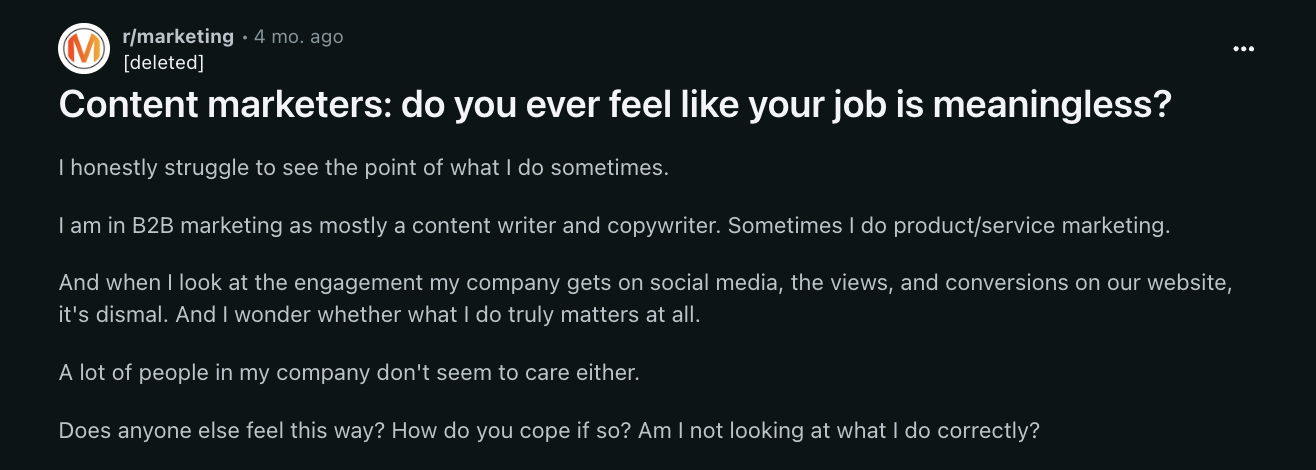Table of Contents
See what’s brimming beneath marketing’s surface. Explore ‘The Deep End’ — a periodic column brought to you by studioID’s Strategy Group.
——————
Spoiler alert: It’s not, but it will fundamentally change as we know it.
If you’ve spent any time on TikTok the past few months (if you are a marketer reading this, yes, you have), you’ve likely noticed an uptick in gloom. And it’s not just from the steady drumbeat of socio-political turmoil fed to us by grassroots reporting — although that’s certainly a contributor. No, something has fundamentally changed with the stories we engage with.
Content creation itself, especially online media, has entered a new era of cynicism. Audiences find it harder to assess the truth. They struggle to find the line between “sponcon” and legitimate storytelling, and brands consistently insert themselves into conversations at the wrong time (no, Target, Elmo was not asking if you were doing OK).
We’ve moved past echo chambers and siloed experiences into a gale-force wind tunnel of derivative, ad-centric content, hitting consumers’ content feeds 24/7.
This further fuels a crisis of trust brands are facing with their audiences as they seek shelter from the worsening storm of bad advertising. The consequences are here: people don’t care if 75% of the brands out there disappear tomorrow.
It’s time we as marketers sit down and face facts: the way we build relationships with audiences, and the way we use content to do it, is coming to an end. As search engine traffic dwindles and social media users abandon what was once a digital public square for the relative safety of private messaging, we need to say goodbye to what once worked and look toward the future of audience-centric, value-driven content marketing. Those who don’t won’t be spared.
Here’s how to spot the signs for what’s coming.
The Four Horsemen of the Content-pocalypse
On the surface, campaigns today might still look like the status quo. You might get a decent amount of traffic to your content hub, and your gated assets continue to deliver a steady stream of leads. But brands are starting to see cracks in the foundation of their content programs, driven by these four areas of weakness.
Creative Copycatting
There’s a copywriting and creative adage as old as time: don’t borrow, steal. In other words, take inspiration from the world around you and the work of others, add your perspective, and remix it into something new and compelling. We seem to have forgotten that last part.
Brands scramble to respond to the latest microtrends and memes every few weeks, only to abandon them for the next set. They all adopt the same tone of voice and messaging as the latest meme or meme-forward brand, pushing toward increased content blanding.
Why do this? In the hopes that the short-term gain of a potential click — that you “know” works — evolves into the lasting benefit of brand salience. Creativity, and good ideas, take time to set in, but we’ve lost patience. And on the B2B side, it’s just as bad. Google anything related to your career field and you’ll be served with a dozen “how-to” articles repackaging the same best practices — optimized for the perfect SEO crawl.
Content For Content’s Sake
As content continues to homogenize, there’s an increased pressure to “keep up” with what other brands are posting, fueling the glut of undifferentiated content. More often than not, this happens when organizations fail to truly understand their audience’s appetite for content and develop a strategy around that need. Faced with the pressure to perform, marketers pump out more of the same formats, the same topics, and the same stories.
A lack of actionable data perpetuates the cycle of sameness. According to a 2024 Hubspot report, 23% of marketers say their company data is inaccessible. Another 65% of marketers say they lack a single source of truth for this data.
AI has the potential to make this situation worse if used incorrectly.
If everyone has the same capacity to instantly produce a 101-article with five focus keywords, it won’t be long before search results are clogged with low-value information.
This is already happening. Last June, Newsguard raised the number of sites it monitors that operate with little or no human oversight and publish articles written largely or entirely by bots from 49 to 217. Bad for content quality, and disastrous for combating misinformation.
Unrealistic Expectations
What does this all build to? Marketers are churning out repetitions of topics and responding to trends too late. When it comes time to assess performance, they are increasingly left holding an emptier bag. Unsurprisingly, marketers are hyper-focused on the sales funnel this year and are seeing stronger conversion from content efforts.
But meeting this demand is difficult to do when content marketers face a fundamental gap between sales goals and what content can accomplish. Not all content assets can (or should) immediately give you leads. But when that’s the expectation, it can be easy to feel like all your efforts are fruitless.
Source: Reddit | r/marketing
Changing Audience Habits
What’s the true sign the content-pocalyspe is upon us? The audience isn’t there anymore. This is particularly clear with the shifting relationship between social media channels and consumers. As these channels have shifted from spaces to build community across shared interests into shopping networks, brands have not done enough to preserve the values that brought audiences onto these platforms.
In fact, Gartner predicts ‘50% of consumers will significantly limit their interactions with social media by 2025.’
We’re seeing this deterioration happen in real-time. Major publishers like The New York Times and The Guardian have seen a staggering drop of over 60% in social media referrals, while consumer brands in particular experience a median decline of 19.6% in organic social media referrals.
Brands are clogging user newsfeeds with content they no longer want, and we’re getting in the way of building true community. So where are our audiences going? Over two-thirds of social media users prefer sharing content and recommendations through private messaging. Facebook Messenger and WeChat combined serve over two billion users globally. And as privacy concerns and frustration over constant ad bombardment grows, brands will continue to see an exodus to these “quieter” spaces.
As much as some content nihilists might try to convince you otherwise, it doesn’t have to be like this. There’s an opportunity to right our wrongs and make it out to the other side not just better marketers, but better brand storytellers.
Four Survival Rules
Who will be the survivors of the content-pocalypse? It will be the content curators and audience builders. While AI and an SEO analysis can give you a list of topics that could align with what your audience wants, savvy marketers will take that initial dose of inspiration and not only tell stories that are unique to their brand values but also publish that content at the right place and time to capture the attention of these audiences.
Take Big Swings
Now is not the time to play it safe. In a world where most audiences don’t care about your brand, make sure yours is the one they can’t stop thinking about. To do that with content, try answering a common question in your industry in a different way, explore new formats, and tell compelling stories.
At studioID, we often borrow from the UX model of problem-solving with “How Might We” exercises, tackling problems from multiple points of view. Suppose you are writing your 100th article about automation in retail warehouses. Instead of creating a listicle about “5 ways robots make your order fulfillment more efficient,” what if you instead created an interactive story exploring a “world without robotic assistance?” Take the time to look beneath the surface and past the over-trodden territory to find a fresh, thought-provoking angle. Your audience will thank you for it.
Make It Personal
As online media and communication continue to fragment into micro-communities, marketers should invest more time adapting existing content strategies to support organic conversations in those spaces. Consider hosting these spaces and investing in community moderation, giving your audience a safe space to connect with like-minded people.
Slack communities like Marketers Chat and Mark Pollard’s Sweathead group are some micro-communities in our industry, but there’s a wide range of these spaces for nearly every niche if you take the time to find them.
Reconnect With Your Audience
Never underestimate the power of asking your community what they want to hear from you. Whether that’s through surveys, qualitative interviews, or even contests, lean on your existing advocates and champions to build a better picture of how you can continue to supply them with valuable content.
Think Like a Human
You are not creating content for a bot. Don’t have a bot create your content. AI can be a powerful thought partner in exploring ideas, running creative ideation sessions, or repackaging your original ideas. But don’t let it dictate the stories your brand should be telling. Instead, lean into the emotion and human motivation behind someone engaging with your content. How does this fulfill a deeper need, connect with them on a relatable level, or solve a pain point? AI can’t give you the answer, but it can help you when you’re ready to actualize it.
Prep for Reinvention
In college, I hung out with some students who ran the school’s radio station. At the time, radio as a dominant medium was already falling out in favor of streaming. The radio station received less than 10 listeners for each broadcast, and it was, like many student groups, propped up by university funding. But the admins of this club had a chant they used to say: Radio is dead, long live radio. Audio content wasn’t going away, it was just changing its approach. Just a few years later, podcasts would become that reincarnation of radio.
Content marketing doom is not upon us. Or, at least it doesn’t have to be. Brands that stay close to what their audiences want, who take creative risks, and who build effective content teams will be just fine. No bunker required.
![]()





